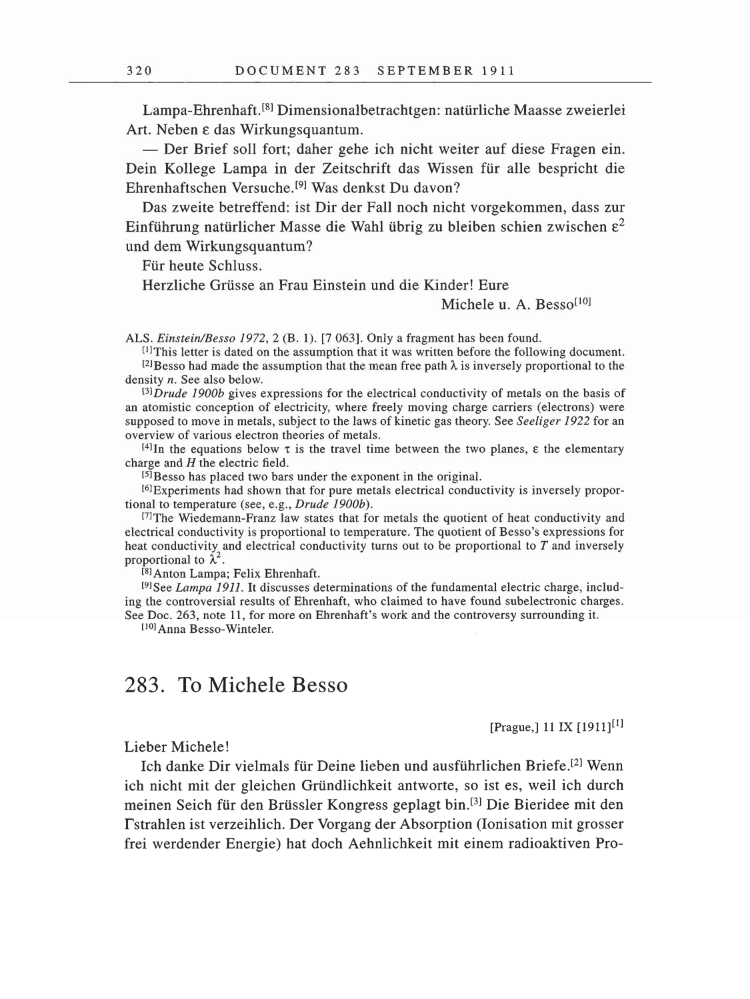320 DOCUMENT 283 SEPTEMBER 1911 Lampa-Ehrenhaft.[8] Dimensionalbetrachtgen: natürliche Maasse zweierlei Art. Neben e das Wirkungsquantum. - Der Brief soll fort daher gehe ich nicht weiter auf diese Fragen ein. Dein Kollege Lampa in der Zeitschrift das Wissen für alle bespricht die Ehrenhaftschen Versuche[9] Was denkst Du davon? Das zweite betreffend: ist Dir der Fall noch nicht vorgekommen, dass zur Einführung natürlicher Masse die Wahl übrig zu bleiben schien zwischen e2 und dem Wirkungsquantum? Für heute Schluss. Herzliche Grüsse an Frau Einstein und die Kinder! Eure Michele u. A. Besso[10] ALS. Einstein/Besso 1972, 2 (B. 1). [7 063]. Only a fragment has been found. [1]This letter is dated on the assumption that it was written before the following document. [2]Besso had made the assumption that the mean free path X is inversely proportional to the density n. See also below. [3]Drude 1900b gives expressions for the electrical conductivity of metals on the basis of an atomistic conception of electricity, where freely moving charge carriers (electrons) were supposed to move in metals, subject to the laws of kinetic gas theory. See Seeliger 1922 for an overview of various electron theories of metals. [4]In the equations below T is the travel time between the two planes, e the elementary charge and H the electric field. [5]Besso has placed two bars under the exponent in the original. [6]Experiments had shown that for pure metals electrical conductivity is inversely propor- tional to temperature (see, e.g., Drude 1900b). [7]The Wiedemann-Franz law states that for metals the quotient of heat conductivity and electrical conductivity is proportional to temperature. The quotient of Besso's expressions for heat conductivity and electrical conductivity turns out to be proportional to T and inversely proportional to X2. [8]Anton Lampa Felix Ehrenhaft. [9]See Lampa 1911. It discusses determinations of the fundamental electric charge, includ- ing the controversial results of Ehrenhaft, who claimed to have found subelectronic charges. See Doc. 263, note 11, for more on Ehrenhaftes work and the controversy surrounding it. [10]Anna Besso-Winteler. 283. To Michele Besso [Prague,] 11 IX [1911][1] Lieber Michele! Ich danke Dir vielmals für Deine lieben und ausführlichen Briefe.[2] Wenn ich nicht mit der gleichen Gründlichkeit antworte, so ist es, weil ich durch meinen Seich für den Brüssler Kongress geplagt bin.[3] Die Bieridee mit den rstrahlen ist verzeihlich. Der Vorgang der Absorption (Ionisation mit grosser frei werdender Energie) hat doch Aehnlichkeit mit einem radioaktiven Pro-
